第三讲 代词、介词、连词、冠词
英语之中名词代词动词形容词冠词数词副词介词连词感叹词

英语之中名词代词动词形容词冠词数词副词介词连词感叹词Modified by JEEP on December 26th, 2020.(一)1、名词名词 (Nouns)是词性的一种,也是实词的一种,是指待人、物、事、时、地、情感、概念等实体或抽象事物的词。
名词可以独立成句。
在短语或句子中通常可以用代词来替代。
2、代词是代替名词的一种词类。
大多数代词具有名词和形容词的功能。
英语中的代词,按其意义、特征及在句中的作用分为:人称代词、物主代词、指示代词、自身代词、相互代词、疑问代词、关系代词和不定代词八种。
3、动词,就是用来形容或表示各类动作的词汇。
基本上每个完整的子句都有一个动词,要表示第二个动作时可使用不定词、动名词、对等连接词、从属连接词或增加子句等方法连结。
根据其在句中的功能,动词可分为四类。
4、形容词形容词【adjective】很多语言中均有的主要词类中的一种。
主要用来修饰名词的词,表示事物的特征5、冠词的定义冠词是置于名词之前,对名词起限制作用的一种虚词。
冠词可以说是名词的一种标志,它不能离开名词而独立存在。
冠词的分类冠词分为不定冠词"a,an"、定冠词"the"和零冠词三种6、数词表示"多少"和"第几"的词,叫数词。
其用法相当于名词或者形容词。
数词分为基数词和序数词两种。
表示数目多少或顺序多少的词叫数词,数词分为基数词和序数词。
7、副词(Adverb)副词的定义: 副词是一种用来修饰动词,形容词,副词或全句的词,说明时间,地点,程度,方式等概念。
8、介词的定义和特征介词是一种用来表示词与词, 词与句之间的关系的词。
在句中不能单独作句字成分。
介词后面一般有名词代词或相当于名词的其他词类,短语或从句作它的宾语。
(二)1、名词,人或事物的名称3、代词,代替名词或者数词(比如some就是代替数目)3、动词,动作或状态4、数词,表示数目或顺序(比如序数词,5th就是表示顺序)5、形容词,人或事物的性质或状态(因为形容词一般修饰名词)6、副词,动作的特征或性状特征(因为副词一般修饰动词或形容词)7、冠词,表示名词的泛指或特指8、介词,表示名词或代词与其他词的关系(因为介词后面一半紧跟名词,代词或其他名词性结构)9、连词,连接词与词,短语与短语,句子与句子10、感叹词,表示说话时的感情或语气(三)1、adj. / a. 形容词用来描述一类物质的性质,状态,外貌,或人的性格特点,性质,品格如:big,happy2、adv. / ad. 副词用来修饰动作或形容词,一般在句子中做状语用表示动作的进行怎样,或表示程度,特点,如:clearly,happily3、prep. 介词连接地点,时间的一类词语,可以表示方位,时间.跟一些表示时间,地点的词连用表示介词词组如:in,to,on,under4、conj. 连词用来连接时间,地点,原因,结果的一类词语如:when,beacuse,so5、num. 数词表示数字的词,既可以是基数词,也可以是序数词如:one,two,first6、int. 感叹词表示感叹的一类词,一般不加一解释,只代表感叹如:what,how,haurray7、vt. 及物动词(后面要加宾语)行为动作的词如:do,finish,play8、vi. 不及物动词(后面不加宾语)表示行为动作的词如:appear9、n. 名词表示物体,物质的词如:pig,cow,man10、pron. 代词代指一类人,事或物的词如:he,she,hers,his,things11、art = 冠词,article的缩写(四)在英语语法中主要把词分为8大类:1.名词:表示人、物或地方等,如:John,teacher;table,pen;London;beauty.2.代词:用来代替名词,以避免重复某个名词,如:I,you,it,that,those,them.3.形容词:用来修饰或限制某个(些)名词,如:good(man),white(paper),every(book),much(water),(John is)hon -est,(He seems)lazy.被修饰或限制的名词,叫做主体词(head-word)。
英语语法知识大全

英语语法知识大全一、词类与词性英语单词根据词性分为名词、动词、形容词、副词、代词、冠词、数词、介词、连词等。
每个单词的词性不同,其在句子中的作用和用法也各不相同。
二、动词时态与语态动词时态表示动作发生的时间和状态,包括现在时、过去时、将来时等。
动词语态则表示动作与主语之间的关系,分为主动语态和被动语态。
三、名词名词是表示人、事物、地点、时间等概念的词。
名词通常可分为可数名词和不可数名词,可数名词有单数和复数形式。
四、代词代词是代替名词的词,分为人称代词、物主代词、反身代词等。
代词在句子中可以作主语、宾语、表语等成分。
五、形容词与副词形容词是用来修饰名词或代词的词,表示人或事物的性质和特征。
副词是用来修饰动词、形容词或其它副词的词,表示动作的方式、程度等。
六、冠词与数词冠词是用来限定名词的词,分为不定冠词和定冠词。
数词是用来表示数量或顺序的词,包括基数词和序数词。
七、连词与介词连词是用来连接单词、短语或句子的词,分为并列连词和从属连词。
介词是用来连接名词或代词与动词、形容词等之间的词。
八、句子结构与类型英语句子结构分为简单句、并列句和复合句。
简单句由一个主语和一个谓语构成,并列句由两个或两个以上的简单句并列而成,复合句由一个主句和一个或多个从句构成。
九、主谓一致主谓一致是指主语和谓语在人称和数上保持一致。
一般情况下,单数主语使用单数谓语,复数主语使用复数谓语。
但在一些特殊情况下,主语和谓语的一致性需要进行特殊处理。
十、疑问句与否定句疑问句是用来提出问题的句子,否定句则是用来表达否定的观点或事实的句子。
疑问句和否定句的结构不同于陈述句,需要根据语法规则进行变化。
十一、从句与关系词从句是指用一个句子来修饰另一个句子的子句,分为名词性从句、定语从句和状语从句等。
关系词是用来引导从句的词,根据从句的类型不同,关系词的种类和使用方法也不同。
十二、虚拟语气与情态动词虚拟语气是一种表达假设条件或主观愿望的语气,情态动词则是用来表达可能性、意愿等的动词。
名词、代词、数词、冠词、介词、连词
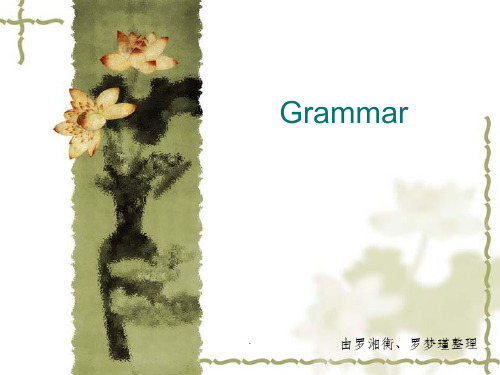
.
人称代词
人称代词(Personal pronouns)在指称 上的特殊性:
it 指代婴儿;she, her常指称轮船、汽车和国家;we, you 有时可泛指一般人;one 有时做单数人称代词, 有时可泛指人们。如:
❖ The distance light travels in one second is somewhere about 300,000 kilometers.
❖ 试用不同短语翻译:大约有7000名学生参加了会议。
.
不定数目的表示法
2. 用and 或or 连接两个相邻的并列数词。如: ❖ The students came into the classroom by twos
• When the repairs had been done, she was a fine and beautiful ship. • We eat to live, not live to eat. • One has to think of the practical side of things.
.
可数名词有单、复数之分。可数名词的复数形 式有以下几种:
情况
加法
例词
一般情况
以s, x, ch, sh结尾的词
加-s 加-es
以辅音+y结尾的词 去y加-ies
以辅音+o 结尾的词 多数加-es
brothers;schools buses;watches;dishes*1 ladies; countries*2 heroes;tomatoes*3
中考重点冠词介词与连词的运用
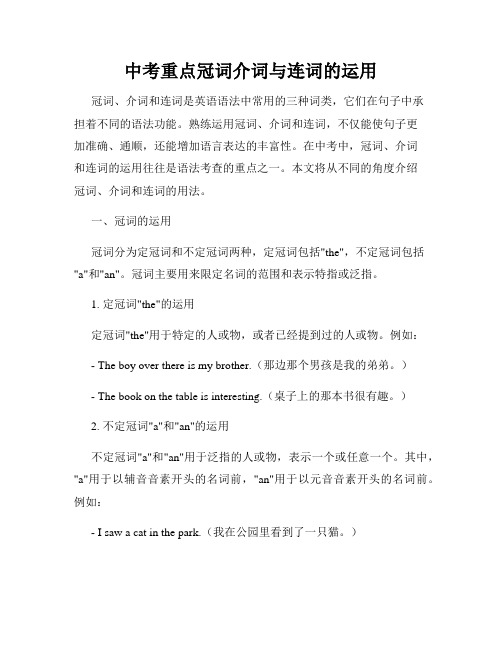
中考重点冠词介词与连词的运用冠词、介词和连词是英语语法中常用的三种词类,它们在句子中承担着不同的语法功能。
熟练运用冠词、介词和连词,不仅能使句子更加准确、通顺,还能增加语言表达的丰富性。
在中考中,冠词、介词和连词的运用往往是语法考查的重点之一。
本文将从不同的角度介绍冠词、介词和连词的用法。
一、冠词的运用冠词分为定冠词和不定冠词两种,定冠词包括"the",不定冠词包括"a"和"an"。
冠词主要用来限定名词的范围和表示特指或泛指。
1. 定冠词"the"的运用定冠词"the"用于特定的人或物,或者已经提到过的人或物。
例如:- The boy over there is my brother.(那边那个男孩是我的弟弟。
)- The book on the table is interesting.(桌子上的那本书很有趣。
)2. 不定冠词"a"和"an"的运用不定冠词"a"和"an"用于泛指的人或物,表示一个或任意一个。
其中,"a"用于以辅音音素开头的名词前,"an"用于以元音音素开头的名词前。
例如:- I saw a cat in the park.(我在公园里看到了一只猫。
)- An apple a day keeps the doctor away.(每天一个苹果,医生远离我。
)二、介词的运用介词是连接词与词、短语与短语的词类,它可以表示时间、地点、原因、方式等概念。
在句子中,介词一般位于名词或代词之前,构成介词短语。
以下是一些常用介词及其用法。
1. 表示时间的介词- at:表示具体某一时间点。
例如:at 8 o'clock(在8点)。
- in:表示某一段时间内。
例如:in the morning(在早上)。
英语之中名词代词动词形容词冠词数词副词介词连词感叹词

(一)1、名词名词 (Nouns)是词性的一种,也是实词的一种,是指待人、物、事、时、地、情感、概念等实体或抽象事物的词。
名词可以独立成句。
在短语或句子中通常可以用代词来替代。
2、代词是代替名词的一种词类。
大多数代词具有名词和形容词的功能。
英语中的代词,按其意义、特征及在句中的作用分为:人称代词、物主代词、指示代词、自身代词、相互代词、疑问代词、关系代词和不定代词八种。
3、动词,就是用来形容或表示各类动作的词汇。
基本上每个完整的子句都有一个动词,要表示第二个动作时可使用不定词、动名词、对等连接词、从属连接词或增加子句等方法连结。
根据其在句中的功能,动词可分为四类。
4、形容词形容词【adjective】很多语言中均有的主要词类中的一种。
主要用来修饰名词的词,表示事物的特征5、冠词的定义冠词是置于名词之前,对名词起限制作用的一种虚词。
冠词可以说是名词的一种标志,它不能离开名词而独立存在。
冠词的分类冠词分为不定冠词"a,an"、定冠词"the"和零冠词三种6、数词表示"多少"和"第几"的词,叫数词。
其用法相当于名词或者形容词。
数词分为基数词和序数词两种。
表示数目多少或顺序多少的词叫数词,数词分为基数词和序数词。
7、副词(Adverb)副词的定义: 副词是一种用来修饰动词,形容词,副词或全句的词,说明时间,地点,程度,方式等概念。
8、介词的定义和特征介词是一种用来表示词与词, 词与句之间的关系的词。
在句中不能单独作句字成分。
介词后面一般有名词代词或相当于名词的其他词类,短语或从句作它的宾语。
(二)1、名词,人或事物的名称3、代词,代替名词或者数词(比如some就是代替数目)3、动词,动作或状态4、数词,表示数目或顺序(比如序数词,5th就是表示顺序)5、形容词,人或事物的性质或状态(因为形容词一般修饰名词)6、副词,动作的特征或性状特征(因为副词一般修饰动词或形容词)7、冠词,表示名词的泛指或特指8、介词,表示名词或代词与其他词的关系(因为介词后面一半紧跟名词,代词或其他名词性结构)9、连词,连接词与词,短语与短语,句子与句子10、感叹词,表示说话时的感情或语气(三)1、adj. / a. 形容词用来描述一类物质的性质,状态,外貌,或人的性格特点,性质,品格如:big,happy2、adv. / ad. 副词用来修饰动作或形容词,一般在句子中做状语用表示动作的进行怎样,或表示程度,特点,如:clearly,happily3、prep. 介词连接地点,时间的一类词语,可以表示方位,时间.跟一些表示时间,地点的词连用表示介词词组如:in,to,on,under4、conj. 连词用来连接时间,地点,原因,结果的一类词语如:when,beacuse,so5、num. 数词表示数字的词,既可以是基数词,也可以是序数词如:one,two,first6、int. 感叹词表示感叹的一类词,一般不加一解释,只代表感叹如:what,how,haurray7、vt. 及物动词(后面要加宾语)行为动作的词如:do,finish,play8、vi. 不及物动词(后面不加宾语)表示行为动作的词如:appear9、n. 名词表示物体,物质的词如:pig,cow,man10、pron. 代词代指一类人,事或物的词如:he,she,hers,his,things11、art = 冠词,article的缩写(四)在英语语法中主要把词分为8大类:1.名词:表示人、物或地方等,如:John,teacher;table,pen;London;beauty.2.代词:用来代替名词,以避免重复某个名词,如:I,you,it,that,those,them.3.形容词:用来修饰或限制某个(些)名词,如:good(man),white(paper),every (book),much(water),(John is)hon-est,(He seems)lazy.被修饰或限制的名词,叫做主体词(head-word)。
英语之中名词、代词、动词、形容词、冠词、数词、副词、介词、连词、感叹词
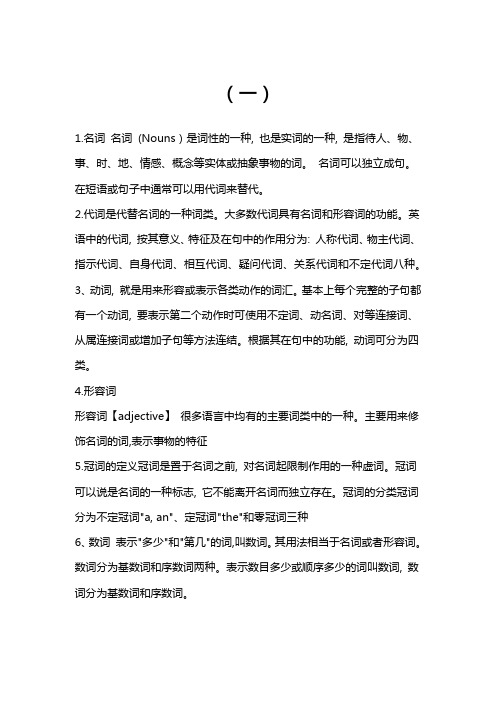
(一)1.名词名词(Nouns)是词性的一种, 也是实词的一种, 是指待人、物、事、时、地、情感、概念等实体或抽象事物的词。
名词可以独立成句。
在短语或句子中通常可以用代词来替代。
2.代词是代替名词的一种词类。
大多数代词具有名词和形容词的功能。
英语中的代词, 按其意义、特征及在句中的作用分为: 人称代词、物主代词、指示代词、自身代词、相互代词、疑问代词、关系代词和不定代词八种。
3、动词, 就是用来形容或表示各类动作的词汇。
基本上每个完整的子句都有一个动词, 要表示第二个动作时可使用不定词、动名词、对等连接词、从属连接词或增加子句等方法连结。
根据其在句中的功能, 动词可分为四类。
4.形容词形容词【adjective】很多语言中均有的主要词类中的一种。
主要用来修饰名词的词,表示事物的特征5.冠词的定义冠词是置于名词之前, 对名词起限制作用的一种虚词。
冠词可以说是名词的一种标志, 它不能离开名词而独立存在。
冠词的分类冠词分为不定冠词"a, an"、定冠词"the"和零冠词三种6、数词表示"多少"和"第几"的词,叫数词。
其用法相当于名词或者形容词。
数词分为基数词和序数词两种。
表示数目多少或顺序多少的词叫数词, 数词分为基数词和序数词。
7、副词(Adverb)副词的定义: 副词是一种用来修饰动词,形容词,副词或全句的词,说明时间,地点,程度,方式等概念。
8、介词的定义和特征介词是一种用来表示词与词, 词与句之间的关系的词。
在句中不能单独作句字成分。
介词后面一般有名词代词或相当于名词的其他词类, 短语或从句作它的宾语。
(二)1.名词, 人或事物的名称3.代词, 代替名词或者数词(比如some就是代替数目)3.动词, 动作或状态4.数词, 表示数目或顺序(比如序数词, 5th就是表示顺序)5.形容词, 人或事物的性质或状态(因为形容词一般修饰名词)6.副词, 动作的特征或性状特征(因为副词一般修饰动词或形容词)7、冠词, 表示名词的泛指或特指8、介词, 表示名词或代词与其他词的关系(因为介词后面一半紧跟名词, 代词或其他名词性结构)9、连词, 连接词与词, 短语与短语, 句子与句子10、感叹词, 表示说话时的感情或语气(三)1.adj./ a.形容词用来描述一类物质的性质,状态,外貌,或人的性格特点,性质,品格如:big,happy2.adv./ ad.副词用来修饰动作或形容词,一般在句子中做状语用表示动作的进行怎样,或表示程度,特点,如:clearly,happily3.prep.介词连接地点,时间的一类词语,可以表示方位,时间.跟一些表示时间,地点的词连用表示介词词组如:in,to,on,under4.conj.连词用来连接时间,地点,原因,结果的一类词语如:when,beacuse,so5.num.数词表示数字的词,既可以是基数词,也可以是序数词如:one,two,first6.int.感叹词表示感叹的一类词,一般不加一解释,只代表感叹如:what,how,haurray7、vt.及物动词(后面要加宾语)行为动作的词如:do,finish,play8、vi.不及物动词(后面不加宾语)表示行为动作的词如:appear9、n.名词表示物体,物质的词如:pig,cow,man10、pron.代词代指一类人,事或物的词如:he,she,hers,his,things11.art = 冠词, article的缩写(四)在英语语法中主要把词分为8大类:1. 名词: 表示人、物或地方等, 如: John, teacher;table, pen;London;beauty.2. 代词: 用来代替名词, 以避免重复某个名词, 如: I, you, it, that, those, them.3.形容词:用来修饰或限制某个(些)名词, 如:good(man), white (paper), every(book), much(water), (John is)hon-est, (He seems)lazy.被修饰或限制的名词, 叫做主体词(head-word)。
小学英语-冠词介词代词总结
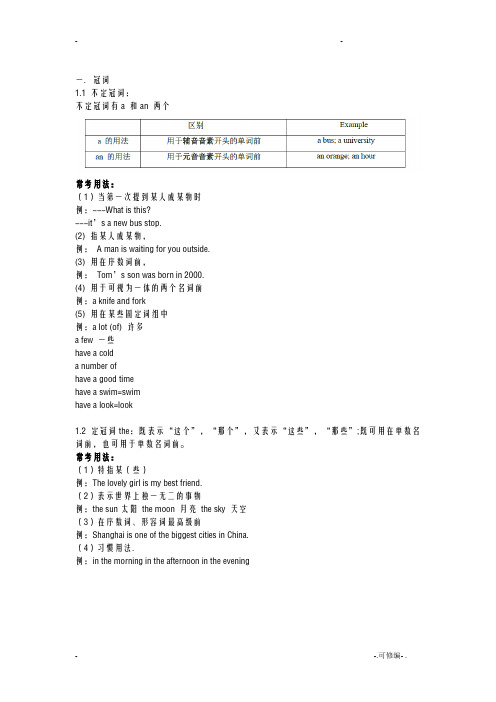
一.冠词1.1 不定冠词:不定冠词有a 和an 两个常考用法:(1)当第一次提到某人或某物时例:---What is this?---it’s a new bus stop.(2) 指某人或某物,例:A man is waiting for you outside.(3) 用在序数词前,例:Tom’s son was born in 2000.(4) 用于可视为一体的两个名词前例:a knife and fork(5) 用在某些固定词组中例:a lot (of) 许多a few 一些have a colda number ofhave a good timehave a swim=swimhave a look=look1.2 定冠词the:既表示“这个”,“那个”,又表示“这些”,“那些”;既可用在单数名词前,也可用于单数名词前。
常考用法:(1)特指某(些)例:The lovely girl is my best friend.(2)表示世界上独一无二的事物例:the sun太阳the moon 月亮the sky 天空(3)在序数词、形容词最高级前例:Shanghai is one of the biggest cities in China.(4)习惯用法.例:in the morning in the afternoon in the evening1.3 不使用冠词的特殊情况(1)国名,人名前通常不用冠词例: I’m from England and my name is Mary.(2)表示交通工具、例: I usually go to school on foot, but sometimes I go to school by bike. (3)季节、月份、节日例:We go to school from Monday to Friday.(4)在三餐、球类运动例:have breakfastplay chess 玩象棋play basketball二.介词2.1 常考时间介词:(1)at:表示具体的点钟或固定搭配中例:at noon, at night, at 7 o(2) in: 表示一段时间以用于表示例:in the twenty(3)on:主要用于在星期几例:on MidonJune 12.2 常考地点介词(1)in, on, to:in 在某一地区之的某方位to 表示在某一地区之外的某方位on 表示与某地的毗邻关系例:Fujian is in the southeast of China.China is to the west of Japan.(2)at, in, on: at 表示较小的地点in 表示较大的地方on 表示在一个平面上例:at the bus stop, at home;in China, in the world;on the farm, on the playground.2.3 易混介词辨析(1)in 和on 的区别:on the tree 表示枝、叶果实等长在树上;in the tree 表示人或其他东西在树上;on the wall表示东西粘贴或挂在墙上;in the wall 表示门、窗等嵌在墙上.(2)between 和among 的区别between 常指“在两者之间”;among 用于指“在三者或三者以上的人或物之间”。
英语词性分类及用法和举例讲解
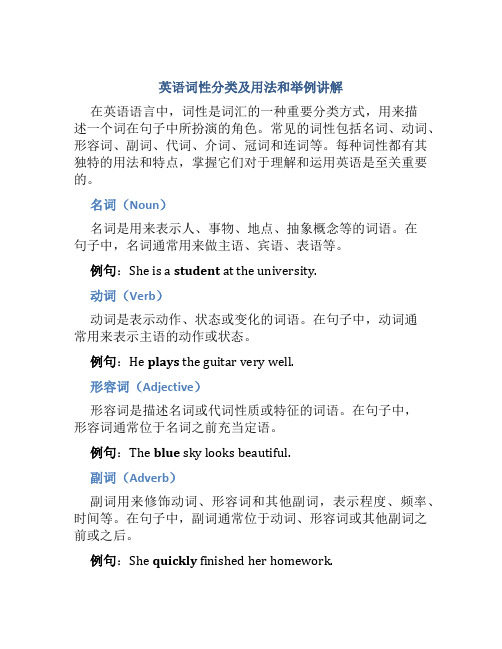
英语词性分类及用法和举例讲解在英语语言中,词性是词汇的一种重要分类方式,用来描述一个词在句子中所扮演的角色。
常见的词性包括名词、动词、形容词、副词、代词、介词、冠词和连词等。
每种词性都有其独特的用法和特点,掌握它们对于理解和运用英语是至关重要的。
名词(Noun)名词是用来表示人、事物、地点、抽象概念等的词语。
在句子中,名词通常用来做主语、宾语、表语等。
例句:She is a student at the university.动词(Verb)动词是表示动作、状态或变化的词语。
在句子中,动词通常用来表示主语的动作或状态。
例句:He plays the guitar very well.形容词(Adjective)形容词是描述名词或代词性质或特征的词语。
在句子中,形容词通常位于名词之前充当定语。
例句:The blue sky looks beautiful.副词(Adverb)副词用来修饰动词、形容词和其他副词,表示程度、频率、时间等。
在句子中,副词通常位于动词、形容词或其他副词之前或之后。
例句:She quickly finished her homework.代词(Pronoun)代词用来代替名词,避免重复使用名词。
常见的代词包括主格代词、宾格代词、物主代词等。
例句:He is my best friend.介词(Preposition)介词用于连接名词、代词或动词与其他词语,表示关系、方向、时间等。
介词通常位于名词或代词前面。
例句:She is at home now.冠词(Article)冠词用来限定名词,包括定冠词“the”和不定冠词“a”和“an”。
例句:I have a cat.连词(Conjunction)连词用来连接词语、短语或句子,使句子结构更加复杂和丰富。
常见的连词有并列连词、从属连词等。
例句:He is reading and writing.通过以上对英语词性分类及用法和举例讲解,我们可以更清晰地理解每种词性在句子中的作用和特点,从而更加准确地运用英语进行表达和沟通。
第三讲代词,介词,连词,冠词

2012初三英语语法讲义(三)代词、介词、连词、冠词(教师)一、代词1.定义:为避免重复而用来代替前文提到的名词的词2.分类:共八类,分别为人称代词(主格和宾格)、物主代词(形容词性和名词性)、反身代词(-self)、指示代词(this, that, these, those), 疑问代词(wh-),不定代词(some,any 及其与thing,body构成的复合词等等),相互代词(each other, one another)和关系代词。
3.人称代词的重难点:1)不同人称代词的顺序问题a.单数人称代词并列作主语和宾语时,其顺序为: you,he/she and I;you ,him/her and me(宾格)b.复数人称代词作主语和宾语时,其顺序为:we,you and they;(主格);us,you and them注意:在下列情况中,第一人称放在前面。
a. 在承认错误,承担责任时。
It was I and John that made her angry. (我和约翰)b. 在长辈对晚辈,长官对下属说话时,如长官为第一人称。
I and you try to finish it.(我和你)2) it 的特别用法a.作形式主语或宾语It’s necessary to buy that dictionary.I consider it important to ask the teacher. (不用that)b. it表示时间,天气,季节,距离,还可以指代上文内容。
It rains all the year.Professor Lee gave us a lecture yesterday. It was of great interest.3) 人称代词单独使用时,常用宾格而不是主格。
-- I’d like to stay here for another week. -- Me too. (I)4. 物主代词的重难点:1) 形容词性物主代词起形容词作用,后面一定要有(有/没有)名词;名词性物主代词相当于名词,后面一定没有(有/没有)名词。
英语之中名词代词动词形容词冠词数词副词介词连词感叹词

(一)1、名词名词(Nouns)是词性的一种,也是实词的一种,是指待人、物、事、时、地、情感、概念等实体或抽象事物的词。
名词可以独立成句。
在短语或句子中通常可以用代词来替代。
2、代词是代替名词的一种词类。
大多数代词具有名词和形容词的功能。
英语中的代词,按其意义、特征及在句中的作用分为:人称代词、物主代词、指示代词、自身代词、相互代词、疑问代词、关系代词和不定代词八种。
3、动词,就是用来形容或表示各类动作的词汇。
基本上每个完整的子句都有一个动词,要表示第二个动作时可使用不定词、动名词、对等连接词、从属连接词或增加子句等方法连结。
根据其在句中的功能,动词可分为四类。
4、形容词形容词【adjective】很多语言中均有的主要词类中的一种。
主要用来修饰名词的词,表示事物的特征5、冠词的定义冠词是置于名词之前,对名词起限制作用的一种虚词。
冠词可以说是名词的一种标志,它不能离开名词而独立存在。
冠词的分类冠词分为不定冠词"a,an"、定冠词"the"和零冠词三种6、数词表示"多少"和"第几"的词,叫数词。
其用法相当于名词或者形容词。
数词分为基数词和序数词两种。
表示数目多少或顺序多少的词叫数词,数词分为基数词和序数词。
7、副词(Adverb)副词的定义: 副词是一种用来修饰动词,形容词,副词或全句的词,说明时间,地点,程度,方式等概念。
8、介词的定义和特征介词是一种用来表示词与词, 词与句之间的关系的词。
在句中不能单独作句字成分。
介词后面一般有名词代词或相当于名词的其他词类,短语或从句作它的宾语。
(二)1、名词,人或事物的名称3、代词,代替名词或者数词(比如some就是代替数目)3、动词,动作或状态4、数词,表示数目或顺序(比如序数词,5th就是表示顺序)5、形容词,人或事物的性质或状态(因为形容词一般修饰名词)6、副词,动作的特征或性状特征(因为副词一般修饰动词或形容词)7、冠词,表示名词的泛指或特指8、介词,表示名词或代词与其他词的关系(因为介词后面一半紧跟名词,代词或其他名词性结构)9、连词,连接词与词,短语与短语,句子与句子10、感叹词,表示说话时的感情或语气(三)1、adj. / a. 形容词用来描述一类物质的性质,状态,外貌,或人的性格特点,性质,品格如:big,happy2、adv. / ad. 副词用来修饰动作或形容词,一般在句子中做状语用表示动作的进行怎样,或表示程度,特点,如:clearly,happily3、prep. 介词连接地点,时间的一类词语,可以表示方位,时间.跟一些表示时间,地点的词连用表示介词词组如:in,to,on,under4、conj. 连词用来连接时间,地点,原因,结果的一类词语如:when,beacuse,so5、num. 数词表示数字的词,既可以是基数词,也可以是序数词如:one,two,first6、int. 感叹词表示感叹的一类词,一般不加一解释,只代表感叹如:what,how,haurray7、vt. 及物动词(后面要加宾语)行为动作的词如:do,finish,play8、vi. 不及物动词(后面不加宾语)表示行为动作的词如:appear9、n. 名词表示物体,物质的词如:pig,cow,man10、pron. 代词代指一类人,事或物的词如:he,she,hers,his,things11、art = 冠词,article的缩写(四)在英语语法中主要把词分为8大类:1.名词:表示人、物或地方等,如:John,teacher;table,pen;London;beauty.2.代词:用来代替名词,以避免重复某个名词,如:I,you,it,that,those,them.3.形容词:用来修饰或限制某个(些)名词,如:good(man),white (paper),every(book),much(water),(John is)hon-est,(He seems)lazy.被修饰或限制的名词,叫做主体词(head-word)。
高考英语语法填空介词、代词、连词、冠词和情态动词知识点汇总

④表示“关于”、“对于”cry over the silt milk
⑤表示“一面……,一面……”talk over a cup of tea
⑥表示“以上”、“超过”over and above, cost over £5
②表示“和”、“与”quarrel/argue with, go with, have nothing to do with
③表示“用”cut it with a knife, have no pen with which to write
④表示伴随状态walk with a stick, with no hat on
④表示理由、原因“因为”for fear of
⑤表示“代替,代表”substitute...for..., speak for
⑥表示“交换”(暗含一定的比例关系)translate word for word
⑦表示时间上、距离上,数量上的“历经……、多达……”for hours, last (for) one hour, run (for) a mile
⑦表示“关注”、“关照”look after, ask after you
above含义为“在……之上”,引申为“难于”、“所不及”、“超过”之意50 feet above sea level, above comprehension
under①表示“在……下”、“在……内部”、“在……脚下”under a tree, under a hill
分析:因these proverbs是名词,且不是作主,宾,表,前面很有可能填介词;句意是“在中国这些成语故事背后常常有有趣的故事”,表示“在......背后”,用介词behind。
什么是词语的词性
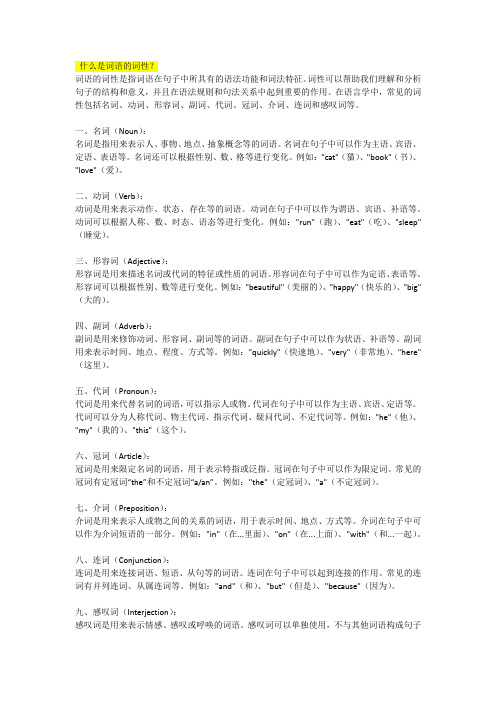
什么是词语的词性?词语的词性是指词语在句子中所具有的语法功能和词法特征。
词性可以帮助我们理解和分析句子的结构和意义,并且在语法规则和句法关系中起到重要的作用。
在语言学中,常见的词性包括名词、动词、形容词、副词、代词、冠词、介词、连词和感叹词等。
一、名词(Noun):名词是指用来表示人、事物、地点、抽象概念等的词语。
名词在句子中可以作为主语、宾语、定语、表语等。
名词还可以根据性别、数、格等进行变化。
例如:"cat"(猫)、"book"(书)、"love"(爱)。
二、动词(Verb):动词是用来表示动作、状态、存在等的词语。
动词在句子中可以作为谓语、宾语、补语等。
动词可以根据人称、数、时态、语态等进行变化。
例如:"run"(跑)、"eat"(吃)、"sleep"(睡觉)。
三、形容词(Adjective):形容词是用来描述名词或代词的特征或性质的词语。
形容词在句子中可以作为定语、表语等。
形容词可以根据性别、数等进行变化。
例如:"beautiful"(美丽的)、"happy"(快乐的)、"big"(大的)。
四、副词(Adverb):副词是用来修饰动词、形容词、副词等的词语。
副词在句子中可以作为状语、补语等。
副词用来表示时间、地点、程度、方式等。
例如:"quickly"(快速地)、"very"(非常地)、"here"(这里)。
五、代词(Pronoun):代词是用来代替名词的词语,可以指示人或物。
代词在句子中可以作为主语、宾语、定语等。
代词可以分为人称代词、物主代词、指示代词、疑问代词、不定代词等。
例如:"he"(他)、"my"(我的)、"this"(这个)。
2021高考英语复习课件:第二部分 专题1 第三讲 介词(短语)

专题一不可忽视的小词冠词、代词和介词(短语)at 表示在某个时间点,at 3:00,at noon ,at that,at Christmas Day 也可表示在某个节假日time on 表示在某一天或某天on Monday ,on Friday evening ,on September 24的一部分表示in the evening ,in a week ,in three days ,in 2019,in my childhood时间at 的介,on ,in 表示在少于或多于一in 天的时间段词morning ,evening ,afternoon ,night 等名词on Monday morning ,on a 如果有表示具体某一天cold winter morning的名词修饰时,用onby表示“不迟于;到……by six o'clock,by the 为止”end of last monthduring表示一段持续的时间,也可以表示这段持续时间中的某一点或某一刻during the summer vaca tion表示时间的介词by,during,for,till,untilfor表示一段时间,后面接具体的时间单位,后边的名词常用复数I have been working herefor five years.Although the lecture wasvery boring,he stayedtill the end of it.till和until表示一段时间,till用在肯定句中与持续性动词连用,until用在否定句中,与瞬间动词连用I didn't leave until 11o'clock.at一般指较小I met him at the的地方store.in一般指较大They arrived in的地方Tianjin yesterday.at,in,onon一般指面与The picture is线接触的地方hanging on the wall.表示地点、位置、方向的介词Baoding lies in thein表示在某一middle of Hebei范围内Province.in,on,to on表示两地接Canada is on thenorth of the USA.to表示范围之Japan is to thenortheast of China.壤外There is a small house by theby 与beside 表示“在……river.的旁边”He was standing beside his father.by ,beside ,nearThere is a school near my house.near 表示“接近;近”表示地点、位置、方向的介词from 强调起点,“从……”The plane from New York arrives at 11:10.from ,out ofout of 侧重从里向外,“从……里出来”She took some paper out of her bag.The secret is only between you and me.between 表示在两者之间between ,amongamong 指三者或三者以上的之间The teacher was standing among the students.for ,from ,of ,through ,with ,because of ,due to ,owing to ,for fear of ,on account of ,out of ,thanks to 等可以表示原因表示原因的介词He was shaking with cold.The girl fell ill from eating too little.by 多用于无形的工具或手段前,by 与名词by hand ,by means of 间无修饰语in ink ,in English ,in by ,in ,in 多用于语言、材料前this way withwith 多用在有形的工具、表示工具、方式、手段的介词We see with our eyes.We are digging with spades(铁锹).表示身体器官的名词前,with 与名词之间可以有修饰语by +交通工具,之间by air ,by car ,by bus ,无冠词by bike in/on +修饰语+交通go to work in my car ,on 工具the busby ,in ,on表示“和……一起;Will you come to the cinema 有……在场”with us ?With time passing by ,he has become used to the climate there.表示“随着;与……一道”表示工具、方式、手段with 的介词The teacher comes into the 表示“具有;携有”classroom with some books inhis hand.He likes to go to bed with the表示方式或状态windows open.of +抽象名词be of great value =be veryvaluable be of +抽象名词=be +adj.to one's surprise =to the surprise of sb to one's joy ,to one's regret ,to one's relief ,to one'sdisappointmentto +情感类to one's +名词=to the +名名词ꢀ词+of sb.call for需要ꢀꢀsearch for寻找;搜索play with同……一起玩;玩弄hold up举起figure out想出refer to提及;参考;查阅focus on集中于exchange...for...用……来交换……“动词+介词”搭配go back to追溯到wait for等待pay for为……付款care about关心;介意dream of梦想rely on依靠contribute to贡献;有助于;促进charge...for...为……要价……apply for申请feel like想要listen to听begin with以……开始pass by经过laugh at嘲笑1.at +n.表示状态at a loss 不知所措ꢀꢀꢀat peace 处于和平状态at war 处于战争状态at work 在工作2.其他以at 开头的介词短语at the beginning of 在……的开始at the cost of 以……的代价“介词+at the risk of 名词”搭at the mercy of 在……支配下;任由……摆布同时冒……的危险配at the same time 3.on +n.表示状态on exhibition/show 在展出on fire 着火on sale 出售;打折on the way 在途中on the decrease/increase 在减少/在增加on holiday/vacation 在度假4.其他以on开头的介词短语on account of因为on behalf of代表on no account/condition决不on the top of在……上面/顶端5.by+n.表示方式by accident偶然地by chance偶然by air/plane乘飞机by coincidence碰巧“介词+名词”搭配by hand用手工by mistake错误地by nature天生地by the day按天算6.in+n.表示方式in cash用现金付款in detail详细地in depth在深度上in height在高度上in English用英语in length在长度上7.其他以in 开头的介词短语in no time 立刻in no way 决不in place of 代替in possession of 拥有;占有in addition to 另外in return 作为回报in charge of 掌管……in spite of 尽管in exchange for 作为交换in favor of 支持;赞成in case of 万一;如果;假使in support of 为支持……“介词+名词”搭配in honour of 为向……表示敬意in memory of 为了纪念……in the middle of 在……中间8.of +n.表示特征(等于相应的形容词)of benefit 有益处的of importance 重要的of use 有用的of help 有帮助的of significance 有意义的of value 有价值的谢谢观赏。
第三讲__英语代词的用法

第三讲__英语代词的用法Unit Three英语代词的用法定义与分类代词是代替名词及起名词作用的短语或句子的词。
代词根据其意思和用法可分为人称代词、物主代词、反身代词、指示代词、相互代词、疑问代词、连接代词、关系代词、不定代词九类。
人称代词,物主代词,反身代词用法概述这三种代词都有人称(一、二、三人称)的变化、数(单、复数)的变化,以及性(阴性、阳性、中性)的变化。
其中,人称代词除了这三种变化外,还有格(主格、宾格)的变化。
物主代词又包括两种形式:形容词性物主代词和名词性物主代词。
特别注意:形容词性物主代词its没有相应的名词性物主代词。
这三种代词的形式变化表如下:人称单复数主格宾格形容词性物主代词名词性物主代词反身代词第一人称单数I me my mine myself 复数we us our ours ourselves第二人称单数you you your yours yourself 复数you you your yours yourselves第三人称单数he him his his himselfshe her her hers herselfit it its 无itself复数they them their theirs themselvesI. 人称代词的用法1) 定义:人称代词是用来指代人、动物或事物的代词。
它必须在人称(第一人称、第二人称、及第三人称)、数(单数、复数)以及性(阴性、阳性、中性)三方面与被指代的名词一致。
如:I am a student. Tom is a boy, and he is a student.Mary is very pretty, and she likes singing.The boys are students, and they are in the room.The dog is small. It is Tom's.2)人称代词的句法功能A) 人称代词有主格和宾语之分:主格用作主语,宾格用作宾语。
初高中必学语法大全

高中英语语法大全学英语必看名词、形容词、代词、数词、冠词、动词、副词、介词、连词、感叹词。
1、名词(n.):表示人、事物、地点或抽象概念的名称。
如:boy, morning, bag, ball, class, orange.2、代词(pron.):主要用来代替名词。
如:who, she, you, it .3、形容词(adj..):表示人或事物的性质或特征。
如:good, right, white, orange .4、数词(num.):表示数目或事物的顺序。
如:one, two, three, first, second, third, fourth.5、动词(v.):表示动作或状态。
如:am, is,are,have,see .6、副词(adv.):修饰动词、形容词或其他副词,说明时间、地点、程度等。
如:now, very, here, often, quietly, slowly.7、冠词(art..):用在名词前,帮助说明名词。
如:a, an, the.8、介词(prep.):表示它后面的名词或代词与其他句子成分的关系。
如in, on, from, above, behind.9、连词(conj.):用来连接词、短语或句子。
如and, but, before .10、感叹词(interj..)表示喜、怒、哀、乐等感情。
如:oh, well, hi, hello.2、句子成分:英语句子成分分为七种:主语、谓语、宾语、定语、状语、表语、宾语补足语。
1、主语是句子所要说的人或事物,回答是“谁”或者“什么”。
通常用名词或代词担任。
如:I’m Miss Green.(我是格林小姐)2、谓语动词说明主语的动作或状态,回答“做(什么)”。
主要由动词担任。
如:Jack cleans the room every day. (杰克每天打扫房间)3、表语在系动词之后,说明主语的身份或特征,回答是“什么”或者“怎么样”。
词汇与语法 第3讲(词汇--名词-代词-主谓一致)

2).两个由and连接的并列名词性分句作主语, 如果主语表示两件事情,动词用复数。例如:
What caused the accident and who was responsible for it remain a mystery to us.
2. ____ is a great pity that there are some disagreements in the school board meeting.
A. That B. This C.√It D. There
.
7
名词&代词
3. We like our English teacher because she often tells ______ funny stories in class.
Most of the money _w_a_s__ recovered by Deputy Player.
Most of the members _w__e_re__ there.
All of the cargo __w_a_s__ lost.
All of the crew _w_e_r_e__ saved.
A.√us B. our C. we D. ours
4. There are 40 teachers in this school , ten of whom are _____.
A.man teachers B. men teacher
B.C. man teacher D. men√teachers
但people, police等只能用复数.
英语之中名词代词动词形容词冠词数词副词介词连词感叹词

(一)1、名词名词(Nouns)是词性的一种,也是实词的一种,是指待人、物、事、时、地、情感、概念等实体或抽象事物的词。
名词可以独立成句。
在短语或句子中通常可以用代词来替代。
2、代词是代替名词的一种词类。
大多数代词具有名词和形容词的功能。
英语中的代词,按其意义、特征及在句中的作用分为:人称代词、物主代词、指示代词、自身代词、相互代词、疑问代词、关系代词和不定代词八种。
3、动词,就是用来形容或表示各类动作的词汇。
基本上每个完整的子句都有一个动词,要表示第二个动作时可使用不定词、动名词、对等连接词、从属连接词或增加子句等方法连结。
根据其在句中的功能,动词可分为四类。
4、形容词形容词【adjective】很多语言中均有的主要词类中的一种。
主要用来修饰名词的词,表示事物的特征5、冠词的定义冠词是置于名词之前,对名词起限制作用的一种虚词。
冠词可以说是名词的一种标志,它不能离开名词而独立存在。
冠词的分类冠词分为不定冠词"a,an"、定冠词"the"和零冠词三种6、数词表示"多少"和"第几"的词,叫数词。
其用法相当于名词或者形容词。
数词分为基数词和序数词两种。
表示数目多少或顺序多少的词叫数词,数词分为基数词和序数词。
7、副词(Adverb)副词的定义: 副词是一种用来修饰动词,形容词,副词或全句的词,说明时间,地点,程度,方式等概念。
8、介词的定义和特征介词是一种用来表示词与词, 词与句之间的关系的词。
在句中不能单独作句字成分。
介词后面一般有名词代词或相当于名词的其他词类,短语或从句作它的宾语。
(二)1、名词,人或事物的名称3、代词,代替名词或者数词(比如some就是代替数目)3、动词,动作或状态4、数词,表示数目或顺序(比如序数词,5th就是表示顺序)5、形容词,人或事物的性质或状态(因为形容词一般修饰名词)6、副词,动作的特征或性状特征(因为副词一般修饰动词或形容词)7、冠词,表示名词的泛指或特指8、介词,表示名词或代词与其他词的关系(因为介词后面一半紧跟名词,代词或其他名词性结构)9、连词,连接词与词,短语与短语,句子与句子10、感叹词,表示说话时的感情或语气(三)1、adj. / a. 形容词用来描述一类物质的性质,状态,外貌,或人的性格特点,性质,品格如:big,happy2、adv. / ad. 副词用来修饰动作或形容词,一般在句子中做状语用表示动作的进行怎样,或表示程度,特点,如:clearly,happily3、prep. 介词连接地点,时间的一类词语,可以表示方位,时间.跟一些表示时间,地点的词连用表示介词词组如:in,to,on,under4、conj. 连词用来连接时间,地点,原因,结果的一类词语如:when,beacuse,so5、num. 数词表示数字的词,既可以是基数词,也可以是序数词如:one,two,first6、int. 感叹词表示感叹的一类词,一般不加一解释,只代表感叹如:what,how,haurray7、vt. 及物动词(后面要加宾语)行为动作的词如:do,finish,play8、vi. 不及物动词(后面不加宾语)表示行为动作的词如:appear9、n. 名词表示物体,物质的词如:pig,cow,man10、pron. 代词代指一类人,事或物的词如:he,she,hers,his,things11、art = 冠词,article的缩写(四)在英语语法中主要把词分为8大类:1.名词:表示人、物或地方等,如:John,teacher;table,pen;London;beauty.2.代词:用来代替名词,以避免重复某个名词,如:I,you,it,that,those,them.3.形容词:用来修饰或限制某个(些)名词,如:good(man),white (paper),every(book),much(water),(John is)hon-est,(He seems)lazy.被修饰或限制的名词,叫做主体词(head-word)。
图说英语表解语法:冠词,连词,介词

图说英语:冠词,连词,介词
冠词
英语中有a,an,和the这三个冠词, a/an为不定冠词, the是定冠词。
有时名词前不用冠词称为零冠词。
冠词是一种虚词, 不能单独作句子成分, 只能放在名词前面, 帮助说明这个名词的含义。
一、冠词的类别和最基本用法
二、不定冠词的使用场合
定冠词的使用场合
三、
四、不用冠词(零冠词)的情况
五、冠词的位置
六、差之一冠, 意差千里
有些词组中, 有无冠词, 意义相处很多, 甚至相反, 常见的词组有:
连词
连词是连接单词短语或句子的一种虚词, 在句子中不单独作句子成分,一般不重读,按照性质分并列连词和从属连词.
一、连词的分类及使用
二、几组常用连词的比较
三、几组较为特殊的连词:
第五章介词
介词是一种虚词, 不能重读, 也不能单独作句子成分, 通常用于名词或相当于名词的词及代词前, 表示其后的词语与句中其他词之间的关系。
介词和名词或代词构成介词短语。
介词短语才能作句子成分。
介词后面的名词或代词称为介词的宾语, 其后的代词需用宾格。
一、介词的分类
二、介词宾语的类型
三、介词短语的句法功能
四、介词和其他词类的搭配
五、易混用的介词短语
六、介词的省略。
- 1、下载文档前请自行甄别文档内容的完整性,平台不提供额外的编辑、内容补充、找答案等附加服务。
- 2、"仅部分预览"的文档,不可在线预览部分如存在完整性等问题,可反馈申请退款(可完整预览的文档不适用该条件!)。
- 3、如文档侵犯您的权益,请联系客服反馈,我们会尽快为您处理(人工客服工作时间:9:00-18:30)。
2012初三英语语法讲义(三)代词、介词、连词、冠词(教师)一、代词1.定义:为避免重复而用来代替前文提到的名词的词2.分类:共八类,分别为人称代词(主格和宾格)、物主代词(形容词性和名词性)、反身代词(-self)、指示代词(this, that, these, those), 疑问代词(wh-),不定代词(some,any及其与thing,body构成的复合词等等),相互代词(each other, one another)和关系代词。
3.人称代词的重难点:1)不同人称代词的顺序问题a.单数人称代词并列作主语和宾语时,其顺序为: you,he/she and I;you ,him/her and me(宾格)b.复数人称代词作主语和宾语时,其顺序为:we,you and they;(主格);us,you and them注意:在下列情况中,第一人称放在前面。
a. 在承认错误,承担责任时。
It was I and John that made her angry.(我和约翰)b. 在长辈对晚辈,长官对下属说话时,如长官为第一人称。
I and you try to finish it.(我和你)2) it 的特别用法a.作形式主语或宾语It’s necessary to buy that dictionary.I consider it important to ask the teacher. (不用that)b. it表示时间,天气,季节,距离,还可以指代上文内容。
It rains all the year.Professor Lee gave us a lecture yesterday. It was of great interest.3) 人称代词单独使用时,常用宾格而不是主格。
-- I’d like to stay here for another week. -- Me too. (I)4. 物主代词的重难点:1) 形容词性物主代词起形容词作用,后面一定要有(有/没有)名词;名词性物主代词相当于名词,后面一定没有(有/没有)名词。
比较:这本书是我的。
This is my book. This book is mine.2) 物主代词不可与a, an, the, this, that, these, those, some, any, several, no, each, every, such, another, which等词一起前置修饰一个名词,而必须用双重所有格。
3) 双重所有格(a friend of mine 的用法)公式为:a, an, this, that +名词+of +名词性物主代词e.g. How many friends of yours(你的多少朋友)will come to the party?5. 反身代词的重难点:1) 可作宾语、同位语、表语等,但不能单独作主语。
判断正误: Myself drive the car. (F)I myself drive the car. (T)2) 当宾语代词与主语指同一人时,宾语要用反身代词。
You should be proud of yourself. (you)比较: Mary saw herself in the mirror. (she)(看到她自己)Mary saw her in the mirror. (she)(看到另外一人)3) oneself亲自(做),相当于personally, in person;by oneself独自(做),相当于alone或独立做;for oneself 独立(做…),自己动手做,相当于without being helped或者“为自己”b. You should go to see him yourself. (you) 你应该亲自去见他。
He likes to take a walk by himself. (he) 他喜欢独自一人去散步。
You should work out problem for yourself. (you) 你应该独立解决这个问题。
4) teach oneself 自学enjoy oneself 过得愉快dress oneself 自己穿衣服can’t help oneself情不自禁help oneself to 随便吃/请自便talk / speak to oneself 自言自语6.指示代词的重难点:1)this, these常指时间,空间离说话者较近人或物;that,those常指时间,空间离说话者较远人或物。
2) that, those用来代替前面说过的事物以免重复。
The weather in Wuhan is much colder than that in Guangzhou in winter. (用this/that填空)The radios made in Guangzhou are better than those made in Changchun.3) that有时可代替句子或句中的一部分。
He was ill. That’s why he didn’t come.7.疑问代词 who/whomWho put the light out before I finished my work?Whom/ who have you chosen to take part in the sports meeting?With whom did you go to the concert?8.不定代词的重难点:1) 包括all, both, each, either, neither, more, little, few, much, many, *another, *other, others, some, any, *every, *no, one以及something, anything, everything, somebody, someone, anybody, anyone, nothing , nobody, no one, none, everybody, everyone.2) 以上既可起名词作用也可用作形容词,但标*的除外,他们只能作定语;“以及”后面的只能起名词作用。
3) all VS both: all指三者及三者以上; both指两者。
a. all的主谓一致:all的单复数由它所修饰或指代的名词的单复数决定。
All goes (go) well.All of the students come (come).b. bothBoth Mary and Mike are students. (beWe both can speak English. (speak)We are both students. 位置在名词前,行为动词前,be动词之后。
(前/后)4) either VS neither: either指两者中任意一个; neither指两者中没有一个,全否定。
a.作主语时,谓语动词多用单数,但有时复数也可以。
Either of the films is/are good. Neither of the films is/are good.b.作定语与单数名词连用。
Either film is good. Neither film is good.c.可用于下列句型,避免重复。
She can't sing,neither (can) he.5) neither VS nora.如不同的人不做同一件事用neither。
e.g. If you don't do it,neither should I.(neither/nor)b.如同一个人不做不同的事用nor,不用neither。
e.g. He can't sing,nor dance,nor skate.6) no one VS none:No one一般指人,其后不能加of短语;none既可指人也可指物,其后能加of短语。
No one 常用来回答who的提问;none常用来回答how many/ much的提问。
①-- Who told you the news? -- No one. I read the newspaper. (no one/ none)②--How much money have you got on you? -- None.a. none of表示若干人(物)中一个也不,谓语动词可单可复。
b.在答语中none可单独使用。
e.g. ---Are there any pictures on the wall?---None.7) one VS that VS it: one表示泛指与前面的名词同类的另一事物,既‘同名异物’;that, it表示特指。
that与所指名词为同类,但不是同一个,而it 与所指名词为同一个。
e.g. I can't find my hat. I think I must buy one.(不定) (one/ that/ it)The hat you bought is bigger than that I bought.(同类但不同个)I can't find my hat. I don' t know where I put it.(同一物)8) some VS anya. some也可与单数名词连用,意为"某一"(= a certain)e.g. You will be sorry for this some day.b. any可用于肯定句,含有任何的意思e.g. Here are three novels. You may read any.c. some用于肯定疑问句中:说话人认为对方的答案会是肯定的,或期望得到肯定回答时。
Would you like句式中,表委婉请求或建议,如:Would you like some coffee?9) one/ another/ the other / others:one… the other只有两个some… the others有三个以上others = other people/things; the others = the rest剩余的全部another泛指另一个a.一定范围内两人(物),一个用one,另一个用the other。
b.一定范围内三者,一个用one,另一个用one (another),第三个可用the other,a third。
